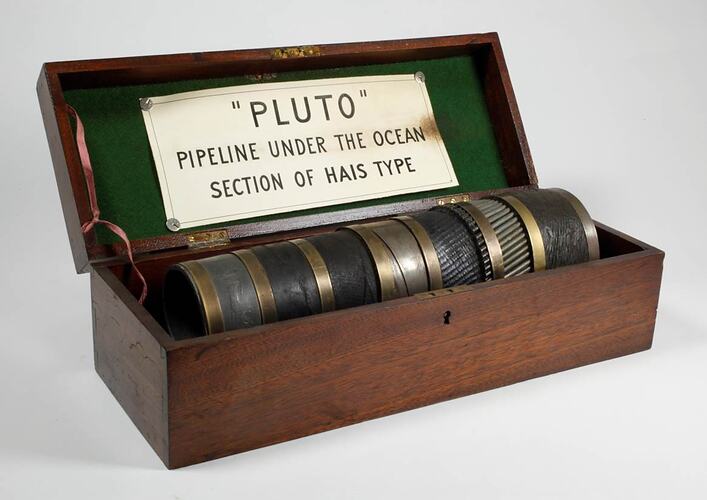Summary
A section of 'PLUTO' (Pipe Line Under The Ocean) with cut-away layers to reveal construction, stored in a wooden display box.
Operation PLUTO was used to supply fuel to the Allied Forces during World War II beginning a few months after D-Day (6 June 1944) until the end of the hostilities. The fuel was supplied from England to France via an undersea pipeline network in the English Channel.
The HAIS (Hartley Anglo-Iranian Siemens) type pipeline, developed by Arthur Hartley, chief engineer of the Anglo-Iranian Petroleum Corporation, was one of two types developed for this purpose. The HAIS type was based on lead and the other type, HAMEL (from contraction of engineers Hammick and Ellis), was based on steel. The HAIS type pipeline had a 3 inch diameter inner lead pipe that was covered in "two layers of prepared paper tape, 1 layer of bitumen prepared cotton tape, 4 layers of mild steel tape, jute bedding, steel armour wires and an outermost layer of jute servings".
The entire operation was one of the greatest secrets of World War II and posed difficult technical challenges, not only in manufacture, but in the laying of the pipeline. Once operational, the pipeline delivered a total of 172,000,000 Imperial gallons of petrol at a rate of up to 1,000,0000 Imperial gallons per day. After the war, 90% of the pipeline was recovered and salvaged for scrap.
Physical Description
Polished wooden box with lockable, hinged lid and dovetail joints. Inside box has green felted cloth lining and two wooden support stands (one loose). Pink cotton ribbon used for support of lid (one ribbon detached). Paper sign printed with text in black ink, pinned with three tacks to inside of lid. Two loose tacks. Sachet of silica gel. Length of metal pipe with progressive outer layers removed to show construction. Banded with eight gold-coloured (brass?) metal hoops or rings.
More Information
-
Collecting Areas
-
Acquisition Information
Long-term Loan from A. D. McKenzie, 1961
-
User
-
Designer of Item Depicted
-
Inscriptions
Sign: ' "PLUTO" / PIPELINE UNDER THE OCEAN / SECTION OF HAIS TYPE '
-
Classification
-
Category
-
Discipline
-
Type of item
-
overall dimensions
475 mm (Length), 80 mm (Width), 150 mm (Height)
Dimensions above are for wooden box. Pipe line section is 380 mm in length with 77 mm inside diameter, 4.5 mm wall thickness and 117 mm outer diameter.
-
References
Hartley, A. C. "OPERATION PLUTO." Journal of the Royal Society of Arts, vol. 94, no. 4706, 1945, pp. 23-34. JSTOR, www.jstor.org/stable/41362941
-
Keywords
Pipelines, Fuel Delivery Equipment, World War II, 1939-1945, Military History




